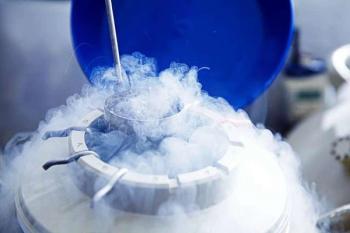
What Is the Evidence that rFSH Is Better than uFSH?
In infertile women undergoing therapy with assisted reproductive techniques, such as in vitro fertilization (IVF) and intracytoplasmic sperm injection (ICSI), the use of gonadotropins to achieve multifollicular development is now well established.
Available for download in Word Document format
In infertile women undergoing therapy with assisted reproductive techniques, such as in vitro fertilization (IVF) and intracytoplasmic sperm injection (ICSI), the use of gonadotropins to achieve multifollicular development is now well established. Until recently, the main source of exogenous FSH for therapeutic use has been the urine of postmenpausal women. Biotechnology has now made available a recombinant preparation of FSH (rFSH) that is very pure and is produced by inserting the genes encoding for ? and ? subunits of FSH into expression vectors that are transfected into a Chinese hamster ovary cell line. The purity and batch -to-batch consistency of rFSH make it an attractive alternative to urinary FSH (uFSH).
Several non-randomized trials have compared rFSH with uFSH and the results have been variable owing, in part, to the bias associated with lack of randomization. Although the gold standard of efficacy evaluation is the randomized controlled trial, (RCT), the published evidence from several RCTs have not allowed definitive conclusions to be drawn on the relative efficacy of the gonadotropin preparations because the sample sizes have been too small. It has been estimated that to demonstrate a 5% improvement in clinical pregnancy rate per cycle started with rFSH compared to a baseline rate of 27% with uFSH, a sample size of _ _ _ subjects would be required to have 80% power and ? = 0.05. None of the studies, to date has had such power.
Consequently, a systematic review and meta-analysis of all RCTs comparing rFSH with uFSH was conducted (1) and the results are summarized below. Identification and Selection of Trials
Trials were identified using a comprehensive search strategy that included electronic data bases such as Medline, Embase and the Cochrane Menstrual Disorders and Subfertility Specialized Register. In addition, hand-searching of journals, bibliographies of review articles and abstracts of major scientific meetings was undertaken, together with consultation of peers and pharmaceutical companies. Out of 17 trials identified, 12 met the selection criteria and were subjected to validity assessment. The methodological quality of the trials varied from moderate to high grading. Apart from minor differences, the patient profiles were quite similar and were representative of the infertile population requesting treatment. All trials used gonadotropin releasing hormone agonists in the long protocol as part of the ovarian stimulation regimen.
Comparative Efficacy
The meta-analysis included 2875 cases, of which 1556 were allocated to rFSH and 1319 to uFSH. There was no significant heterogencity of treatment effect across all trials. The common odds ratio (OR) for clinical pregnancy per started cycle, obtained by pooling the data using a fixed-effects model, was 1.20 (95% confidence interval (Cl) 1.02 - 1.42, p = 0.03) in favour of rFSH. This result represented a risk difference of 3.7% (0.5 - 6.9%). The respective ORs for follitropin alpha and follitropin beta were 1.21 (0.97 - 1.51, p = 0.09) and 1.19 (0.93 - 1.53, p = 0.16). Among patients who underwent IVF, the respective ORs for follitropin alpha and follitropin beta were 1.36 (1.02 - 1.80, p = 0.035) and 1.19 (0.93 - 1.53, p = 0.16). There were no trials using follitropin beta in ICSI to allow relative efficacy comparisons for the alpha and beta preparations.
Conclusions
The overall conclusion, using the evidence from all the available RCTs, is that the clinical pregnancy rate per started cycle is statistically significantly higher with rFSH than with uFSH.
References:
Reference
1. Daya S, Gunby J. Recombinant versus urinary follicle stimulating hormone for ovarian stimulation in assisted reproduction. Hum Reprod 1999;14:2207-2215.
Newsletter
Get the latest clinical updates, case studies, and expert commentary in obstetric and gynecologic care. Sign up now to stay informed.















